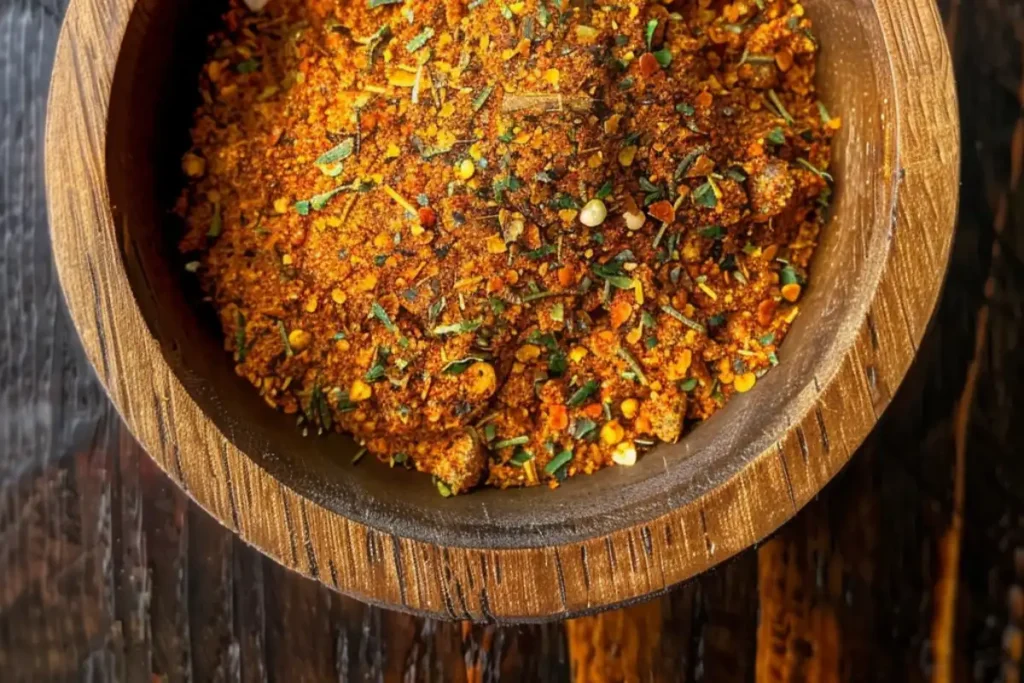Buffalo seasoning has become a favorite in American kitchens for its tangy, spicy flavor that elevates a wide range of dishes. This seasoning blend packs a punch, transforming simple chicken wings, vegetables, and even dips into something unforgettable. While many associate This spice blend with the famous Buffalo wings, it has evolved into a versatile ingredient that can be used on various dishes.
In this article, we’ll break down the ingredients of this spice blend, explore its history, show how to use it in different dishes, and even explain how to make your own homemade version. Let’s dive into the world of buffalo flavor and discover why this seasoning has become so popular.
Introduction to Buffalo Seasoning
Buffalo seasoning, like the classic buffalo sauce, offers a tangy, spicy flavor profile with ingredients such as cayenne pepper, paprika, garlic powder, and onion powder. While the sauce uses hot sauce and butter, the seasoning comes in a dry spice blend that delivers the same heat and tanginess without needing liquid ingredients.
Buffalo seasoning now goes beyond wings. People use it to season everything from roasted vegetables to burgers and fries, adding a spicy kick to many dishes. Whether you’re grilling, roasting, or frying, This spice blend provides an easy way to infuse dishes with bold flavor.
For those who are curious about seasoning dishes in creative ways, you might want to explore this Street Corn Pasta Salad recipe, which uses a combination of spices to elevate a classic pasta dish.

Origins of Buffalo Wings and Buffalo Seasoning
Buffalo seasoning originated from the invention of Buffalo wings, first served in Buffalo, New York, in 1964. Teressa Bellissimo at Anchor Bar created the famous Buffalo wings by tossing fried chicken wings in a mixture of hot sauce and butter. The sauce became so popular that it inspired the creation of buffalo seasoning, transforming the flavors into a dry spice blend for more versatile use
Today, buffalo seasoning has expanded far beyond its humble roots, and you’ll find it on store shelves in premade blends or as a homemade staple in many kitchens.
What is Buffalo Seasoning Made Of?
Buffalo seasoning is a blend of various spices and herbs, each bringing something unique to the table. While the exact ingredients can vary depending on the recipe or brand, the core components generally remain the same. Here’s a breakdown of the essential and optional ingredients:
Core Ingredients
- Cayenne Pepper
- Cayenne pepper is the key ingredient that gives This spice blend its heat. It’s what makes the seasoning spicy and tangy. Cayenne also contains capsaicin, which gives it its heat and contributes to health benefits such as reducing pain and boosting metabolism.
- Paprika
- Paprika adds a subtle smokiness and sweetness to the seasoning. There are different varieties of paprika, including smoked, sweet, and hot paprika, each offering a different flavor profile. To learn more about the varieties of paprika, check out different types of paprika.
- Garlic Powder
- Garlic powder gives buffalo seasoning a savory, slightly sharp flavor that complements the heat of the cayenne. It’s a versatile spice used in many seasoning blends. You can explore more about how garlic powder is made and its uses here.
- Onion Powder
- Like garlic powder, onion powder adds a savory depth to the seasoning. It pairs well with the garlic to give the seasoning a balanced, full flavor.
- Salt and Black Pepper
- Salt is essential for enhancing the flavors of the other spices, while black pepper adds an additional layer of heat and spice.

Optional Ingredients
For those who want to personalize their spice blend, there are several optional ingredients you can add:
- Chili Powder or Red Pepper Flakes
- For an extra kick of heat, you can add chili powder or red pepper flakes to your seasoning mix.
- Celery Salt
- Celery salt is often associated with buffalo wings because celery is typically served as a side with buffalo-flavored dishes. It adds a tangy, salty flavor to the seasoning.
- Brown Sugar
- Some people like to add a touch of sweetness to balance out the heat, making brown sugar a perfect addition for those who prefer a more well-rounded flavor profile.
How to Use Buffalo Seasoning in Cooking
While buffalo seasoning is most famously used for chicken wings, its versatility extends far beyond that. Here are some great ways to incorporate This spice blend into your cooking:
Buffalo Chicken Wings
- Classic Use: The most popular way to use buffalo seasoning is as a rub for chicken wings. To use it, simply coat the wings in olive oil and sprinkle the seasoning generously before baking, frying, or grilling. You can also toss the cooked wings in This spice blend for an extra kick.
- Pro Tip: For an extra crispy texture, bake the seasoned wings in a hot oven, flipping halfway through. The seasoning adds flavor while ensuring the wings stay crispy.
Roasted Vegetables
- Spicy Vegetables: Buffalo seasoning can turn bland vegetables into a flavorful side dish. Try roasting cauliflower, carrots, or zucchini with buffalo seasoning and olive oil. The heat from the cayenne and the savory flavors from the garlic and onion powder make the vegetables irresistible.
- Tip: Roasting at a high temperature will caramelize the veggies, enhancing their natural sweetness while This spice blend adds bold flavor.
Buffalo Burgers
- Ground Meat: Mix buffalo seasoning into ground beef, turkey, or chicken to create flavorful buffalo burgers. The seasoning adds a spicy kick to each bite, making it a great alternative to traditional burger seasonings.
- Pro Tip: You can top your buffalo burgers with blue cheese for the full Buffalo wing experience, adding another layer of richness to balance the heat.
Buffalo Dips
- Perfect for Parties: Buffalo seasoning can also be added to dips, like cream cheese or sour cream, to create a buffalo dip. Serve it with chips or vegetables for an easy, crowd-pleasing appetizer.
- Pro Tip: For a layered buffalo dip, mix cream cheese, This spice blend, and shredded cheese, then bake until bubbly. Serve hot with tortilla chips or celery sticks.
For those who are fans of creative dipping sauces or pairing their dishes with complementary sides, you might want to explore more ideas in the best side dishes for shrimp pasta to expand your culinary repertoire.
Homemade vs. Store-Bought Buffalo Seasoning
This spice blend can be purchased pre-made, or you can make your own blend at home. Both options have their pros and cons, depending on your needs and preferences.
Advantages of Homemade Buffalo Seasoning
- Customization: When you make buffalo seasoning at home, you have full control over the ingredients. You can adjust the heat level by adding more or less cayenne, or you can add different spices like smoked paprika for a unique twist.
- No Additives: Store-bought seasonings often contain preservatives and other additives to extend shelf life. By making your own, you can ensure your seasoning is all-natural and free of unnecessary chemicals.
- Cost-Effective: Making This versatile spice mix at home is usually cheaper in the long run, especially if you frequently use the spices in other recipes.
Store-Bought Buffalo Seasoning
If you’re short on time or prefer the convenience of store-bought, there are plenty of This spice blend blends available at most grocery stores. These blends are consistent in flavor, but they may contain extra salt or preservatives. Some popular brands include McCormick and Buffalo Wild Wings, which offer reliable flavor profiles.
- Convenience: Store-bought This versatile spice mix is ready to use right out of the bottle. No measuring or mixing is required.
- Consistency: With store-bought blends, you know what to expect in terms of flavor and heat level every time.
FAQs: What is Buffalo Seasoning Made Of?
What is Buffalo Seasoning Made Of?
This versatile spice mix typically includes cayenne pepper, paprika, garlic powder, onion powder, salt, and black pepper. Some variations may also contain chili powder, celery salt, and brown sugar for added flavor.
Is Buffalo Seasoning Spicy?
Yes, buffalo seasoning is generally spicy due to the cayenne pepper and sometimes chili powder. The heat level can be adjusted by altering the amount of cayenne used in the blend.
Can I Use Buffalo Seasoning on Dishes Other Than Chicken?
Absolutely! You can use This spice blend on a variety of dishes, including roasted vegetables, burgers, and dips. It adds a bold, spicy flavor to almost any meal
What’s the Difference Between Buffalo Sauce and Buffalo Seasoning?
Buffalo sauce combines hot sauce and butter in a liquid form, while buffalo seasoning serves as a dry spice blend. Both offer a spicy, tangy flavor, but This versatile spice mix is more versatile and can enhance dishes in ways that buffalo sauce cannot.
Conclusion
Buffalo seasoning is a must-have for anyone who loves bold, spicy flavors. Whether you’re using it for classic Buffalo wings or experimenting with new dishes like roasted vegetables or buffalo-flavored dips, this versatile seasoning can take your cooking to the next level. The combination of cayenne pepper, paprika, garlic powder, and other spices creates a well-balanced seasoning that’s both flavorful and adaptable.
For more inspiration on using spices creatively, explore the best side dishes for shrimp pasta and elevate your meals to new heights. And don’t be afraid to experiment with making your own buffalo seasoning at home—you might just discover your perfect flavor blend!

